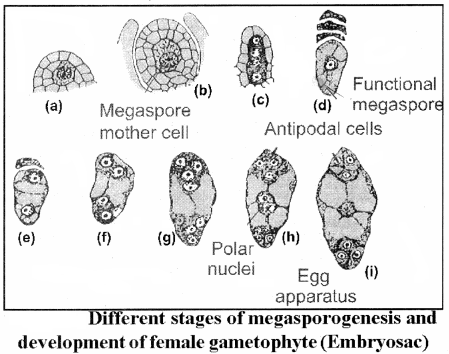Rajasthan Board RBSE Class 12 Biology Chapter 2 Male and Female Gametophyte: Structure and Development
RBSE Class 12 Biology Chapter 2 Multiple Choice Questions
Question 1.
What is the role of the innermost wall layer, the tapetum in pollen sac?
(a) Dehiscence
(b) Safety
(c) Nutrition
(d) Mechanical
Answer:
(c) Nutrition
Question 2.
Ubisch bodies are formed by –
(a) Epidermis
(b) Endothecium
(c) Tapetum
(d) Integument
Answer:
(c) Tapetum
![]()
Question 3.
How many meiotic divisions are required for the production of 100 pollen grains in Pollen sac/pollen chamber?
(a) 100
(b) 75
(c) 50
(d) 25
Answer:
(d) 25
Question 4.
Female Gametophyte is –
(a) Embryo
(b) Embryo sac
(c) Endosperm
(d) Accessory cells
Answer:
(b) Embryo sac
Question 5.
In mature Polygonum type of embryo sac, these are found –
(a) Seven cells and eight nuclei
(b) Seven nuclei and eight cells
(c) Eight cells and eight nuclei
(d) Seven cells and seven nuclei
Answer:
(a) Seven cells and eight nuclei
Question 6.
How many male gametes are formed in pollen grain in Angiospermic plants –
(a) One
(b) Two
(c) Three
(d) Four
Answer:
(b) Two
RBSE Class 12 Biology Chapter 2 Very Short Answer Questions
Question 1.
How many types of tapetum are there? Write their name.
Answer:
There are two types of tapetum in angiosperms. These are amoeboid or plasmodial and secretory or glandular. These provide nutrients to the pollen grains.
Question 2.
What is pollen kit?
Answer:
On the surface of the insect-pollinated pollen grains, an oily layer is found. This layer has a specific colour, odour and sticky nature are known as pollen kit.
Question 3.
From which place pollen tube comes out of pollen grain?
Answer:
There are small thin areas in the otherwise thick and hard exine. These are called germ pores. The pollen tube comes out from the germ pore.
![]()
Question 4.
What is the egg apparatus?
Answer:
The egg cell and the two synergids present along with egg cell constitute the egg apparatus.
Question 5.
How the secondary nucleus is formed?
Answer:
The secondary nucleus is formed by the fusion of two polar nuclei.
Question 6.
Which type of ovule is found in Cactus?
Answer:
Circinotropous ovule is found in Cactus.
Question 7.
Where is megaspore mother cell formed?
Answer:
Megaspore mother cell is formed in the hypodermal region of nucellus at the micropylar end of an ovule.
Question 8.
How many nuclei are formed in the monoscopic embryo sac?
Answer:
The monosporic embryo sac is eight puçleated.
Question 9.
What type of ovule is found in a majority of angiosperms?
Answer:
The typical ovule of angiosperms is anatropous or inverted type.
Question 10.
What is meant by the term dithecous?
Answer:
A typical anther contains two lobes. This condition is referred to as bilobed or dithecous anther.
Question 11.
How many pollen chambers are formed in the anther?
Answer:
A typical anther consists of four pollen chambers.
Question 12.
Name different layers of the wall of the anther.
Answer:
Anther wall consists of four layers – namely –
- epidermis
- endothecium
- middle layers
- tapetum
Question 13.
What is the role of endothecium?
Answer:
Besides protection of contents of pollen sac, endothecium ensures dehiscence of anther at mature.
![]()
Question 14.
Define the terms – Hilum, Funicle and Chalaza.
Answer:
- Hilum – The point of attachment of the body of the ovule with its stalk is called hilum. Funicle – The stalk of the ovule is called funicle.
- Chalaza – The basal part of the body of ovule from
- where the integuments arise is called chalaza.
Question 15.
How many pollen tetrads will be formed by the meiotic division of 16 pollen mother cells?
Answer:
16 pollen tetrads.
Question 16.
How many megaspores are formed from the meiotic division of one megaspore mother cells?
Answer:
Four megaspores.
RBSE Class 12 Biology Chapter 2 Short Answer Questions
Question 1.
Write functions of the tapetum.
Answer:
Tapetum cells provide nutrition for developing pollen. Besides this, the tapetum cells deposit sporopollenin substance and help in the formation of the epidermal coat of pollen. The importance of tapetum can be understood by the fact that if the tapetum degenerates before the formation of pollen grains, the pollen grains remain sterile or abortive.
Question 2.
Write in detail, the structure of pollen grain.
Answer:
Pollen grains in angiosperms are unicellular, uninucleate, haploid, non-motile normally round structure. The nucleus and dense cytoplasm are covered by a two-layered wall. The outer layer is thick, stiff and protective and is called exine. The inner layer is thin and elastic and is made up of cellulose and pectin. There are a few thin areas in the exine called germ pores.
![]()
Question 3.
What are Ubisch bodies?
Answer:
The fatty substances deposited on the wall of pollen by the secretions of tapetal cells ore termed as Ubisch bodies.
Question 4.
Draw a well-labelled diagram of a typical ovule.
Answer:
The typical ovule of angiosperms is anatropous ovule.
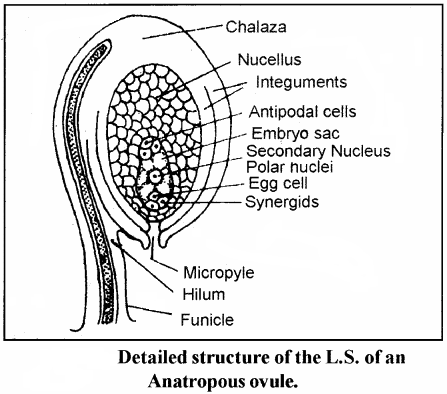
Question 5.
Draw a well-labelled diagram of Polygonum type of embryo sac.
Answer:
Polygonum type embryo sac develops from one functional megaspore. It is eight nucleated, seven celled structure.
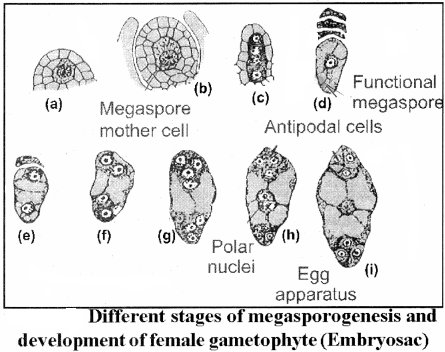
Question 6.
Differentiate between orthotropous and anatropous ovule.
Answer:
The orthotropous ovule is straight in its orientation on the placenta and hence, the funicle, chalaza and micropyle lie in one straight line. Whereas in anatropous ovule the body of the ovule is inverted and is turned at an angle of 180° so that the micropyle and the hilum come to lie close to each other.
Question 7.
Write a brief account of the structure of ovule of angiosperms.
Answer:
A mature ovule of angiosperms is almost oval and has the following parts. The body of the ovule is called the nucellus. It remains covered by two integuments. These arise from the base of the ovule. At the free end of the ovule, the integuments are incomplete and so there is a minute opening called micropyle. The stalk of the ovule is called as funicle. The point of attachment of the body of an ovule with the stalk is called hilum. The base of the ovule from where integuments arise is called chalaza.
![]()
Question 8.
Describe the structure of the female gametophyte of angiosperms.
Answer:
Female gametophyte of angiosperms is also called embryo sac. A typical female gametophyte is monoscopic and Polygonum type. It has four nuclei at the micropylar end and four nuclei at the chalazal end. Three nuclei at the micropylar end organize into egg apparatus consisting of an egg cell and two synergids and one nucleus migrate towards the centre. It is called polar nucleus. Similarly, three nuclei at chalazal end organize into three antipodal cells and one polar nucleus migrates towards the centre. Thus a mature female gametophyte has egg apparatus, three antipodal cells and two polar nuclei.
Question 9.
Write the role of synergids, polar nuclei and antipodal cells.
Answer:
Synergids play some role in guiding entry of pollen tube into embryo sac in close vicinity of an egg cell. The two polar nuclei fuse to form a secondary nucleus or definitive nucleus which after an act of double fertilization forms triploid nutritive tissue called endosperm. The antipodal cells play some role in regulating the act of fertilization and double fertilization, but how, is not yet clearly understood.
![]()
RBSE Class 12 Biology Chapter 2 Essay Type Questions
Question 1.
Describe in detail the structure of pollen sac with the help of well-labelled diagrams.
Answer:
Each pollen sac has a chamber surrounded by the wall. The wall is differentiated into four layers at maturity. The mass of cells enclosed by the wall layers is called sporogenous cells. These cells divide by mitotic division and the last crop of mitotic division forms microspore mother cells.
The microspore mother cells or pollen mother cells undergo meiosis to form microspores or pollen. Thus the pollen chamber or pollen sac contains pollen surrounded by wall layers. These four layers are arranged in a specific order and are as follows:
- Epidermis
- Endothecium
- Middle layers
- Tapetum
1. Epidermis: The epidermal cells of the wall of anther become stretched and flattened as the anther enlarges. It provides protection to anther.
2. Endothecium: The cells of the parietal layer lying below the epidermis are thickly walled and radially elongated. Internal wall has deposition of cellulose and forms fibrous bands which are U-shaped. These cells are hygroscopic in nature and in dry condition stress or tension is created which leads to dehiscence of the anther.
3. Middle Layers: Beneath the endothelium is present two to three layers of cells called middle layers. These cells are thinly walled.
4. Tapetum: The innermost wall layer, situated just inside the middle layers is called tapetum. The tapetum surrounds the sporogenous tissue. The cells of this layer divide freely and form a layer of enlarged cubical cells around the sporogenous tissue. As the microsporogenesis tissue develops, the cells of tapetum elongate centripetally, become
multinucleate and get filled with dense cytoplasm.
On the basis of the nature of cells, the tapetum can be amoeboid or plasmodial and secretory or glandular type. Most dicotyledonous plants have a secretory or glandular type of tapetum.
The rounded structures of fatty nature found in the tapetal cells are called Probisch bodies. These are converted into Ubisch bodies by deposition of sporopollenin.
Sporopollenin is most resistant polysaccharide and is an important constituent of the outer wall layer (Exine or exospore) of pollen grains.
![]()
As the process of microsporogenesis progresses, the cells of the tapetum and the middle wall layers dissolve and contribute to the nutrition and auxin requirement of dividing microspore mother cells.
It has been observed that if the cells of tapetum degenerate prior to the formation of microspores or pollen, then the pollen grains fail to attain maturity and may become sterile or abortive.
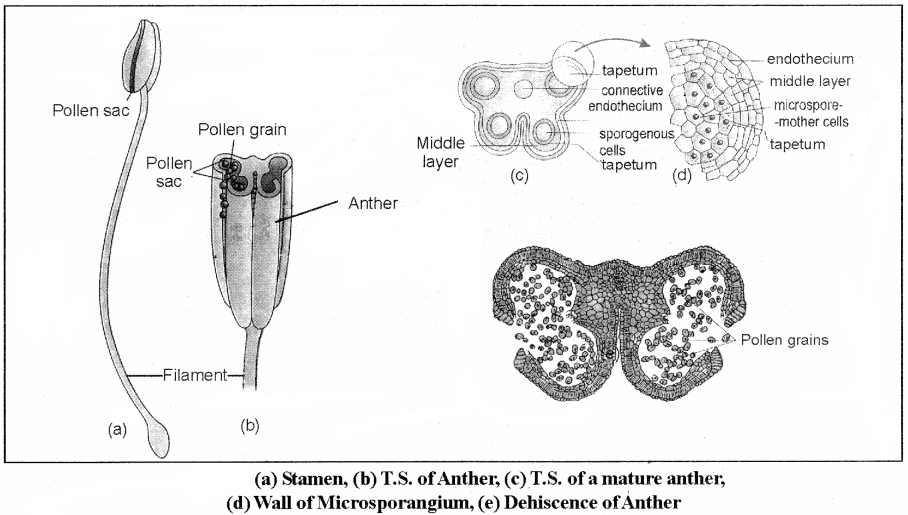 Question 2.
Question 2.
How many types of pollen or microspore tetrads are formed? Explain with the help of well-labelled diagrams.
Answer:
In angiosperms, five different types of pollen tetrads can be formed. These are:
- Tetrahedral
- Isobilateral
- Decussate
- T-shaped
- Linear
1. Tetrahedral: Only three microspores are observed when we view from one side and fourth microspores are at the backside.
Example: Most dicotyledonous plants.
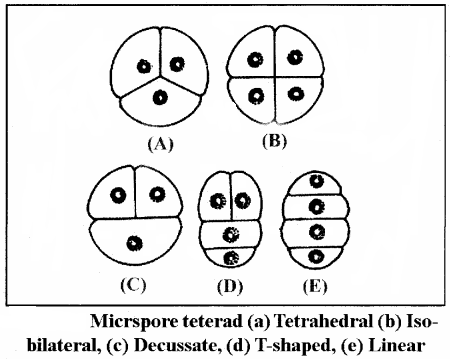
2. Isobilateral: In this, all four microspores are arranged in one plane of the tetrad.
Example: Monocot plants.
3. Decussate: In this two + two microspores are arranged perpendicular in such a way that upper two microspores are visible and only one from lower tier is visible.
Example: Magnolia.
4. T-shaped: In this microspores are arranged in a tetrad in such a way that two microspores are arranged in transverse and two in a longitudinal plane.
Example: Aristolochia.
![]()
5. Linear: All microspores are arranged in a single linear fashion.
Example: Halophylla.
The wall between the microspores is made up of callose. This wall is degraded by enzyme collapse as a result of which the microspores separate from each other and become spherical. At this stage, these are seen freely distributed in the pollen chamber and are called pollen grains.
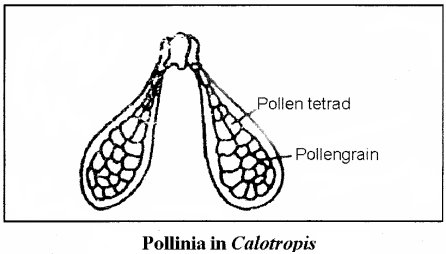
In some plants, pollen grains or microspores of a sporangium cohere (stick) in a single mass called pollinium.
Example: Calotropis and in some orchids.
Most commonly the microspores soon separate from one another but sometimes they adhere in tetrads to from compound pollen grains.
Example: Drimys, Anona, Drosera, Elodea, Typha. If there are more than four microspores in tetrad then this stage is known as Polyspory.
Question 3.
Describe types of ovules diagrammatically.
Answer:
In angiosperms, six different types of ovules can be formed. These are:
- Orthotropous
- Anatropous
- Campylotropous
- Amphitropous
- Hemianatropous
- Circinotropous
1. Orthotropous ovule: “The micropyle, chalaza and funicle lie in one straight line”.
Example: family Polygonaceae, Piperaceae and ovule of most gymnosperms.
2. Anatropous (Inverted) ovule: The body of the ovule is completely inverted so that micropyle and hilum come to lie very close to each other. 82% of families of angiosperms contain this type of ovule.
Example: plants of gamopetalous.
3. Campylotropous: When the ovule is curved, the micropyle is directed towards chalaza. Chalaza is situated at right angles to funicle.
Example: Members of Cruciferae and Leguminosae family.
4. Amphibious or Transverse Ovule: The ovule curvature is more pronounced and embryosac becomes horse-shoe shaped.
Example: Families Alismaceae, Butumaceae.
![]()
5. Hemianatropous Ovule: When nucellus and integuments lie more or less at right angles to the funicle.
Example: Families Ranunculaceae and Primulaceae.
6. Circinotropous ovule: The funicle is exceptionally long and forms a complete circle around the ovules, which is free from it except for a small area at the end of funicle.
Example: Opuntia and other members of families Cactaceae and Plumbaginacea.
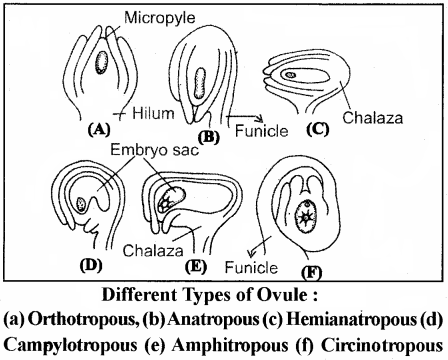
Question 4.
Describe the development of male gametophyte with the help of well-labelled diagrams.
Answer:
Microspore or pollen grain is the first cell of the male gametophytic generation. It begins to develop into male gametophyte in situ i.e. while inside the pollen sac. The first division of the nucleus results in the formation of a small generative nucleus situated towards the wall and a large vegetative nucleus or tube nucleus.
After nuclear division (karyokinesis) cytokinesis or wall formation results in the formation of a smaller (lenticular)generative cell and a larger vegetative cell. Subsequently, the generative cell divides to form two male gametes and the vegetative cells grow out to form the pollen tube.
The germinated pollen grain is called male gametophyte. Microspore or pollen grain is the first cell of the male gametophytic generation. Microspores or pollen grains through the process of gametogenesis form male gametophyte. In this process nucleus of pollen grain divides to form a small lenticular generative cell and a bigger vegetative cell. The generative cell forms two male gametes by mitotic division.
Development of Male Gametophyte:
Microspore is the first cell of male gametophyte. This cell is filled with dense cytoplasm and a distinct nucleus. After being separated from tetrad it increases in size. The cytoplasm appears as single-layered villi like and many vacuoles are formed. Some of the stages of development of male gametophyte are completed before pollination and some after pollination.
Before pollination, the nucleus of pollen grain divides by mitosis into the large vegetative nucleus and small generative nucleus and then by the formation of wall between these two nuclei leads to the formation of larger vegetative cell and a smaller generative cell. Generally in most of the plant’s pollination occurs at this two nucleated stage. The pollen grain after liberation from pollen sac reaches the stigma of the flower.
Initially, a generative cell is attached with a wall of the pollen grain, but after the formation of the complete wall, it separates from the wall of the pollen grain and moves towards the vegetative cell. After separation from the pollen wall, the generative cell becomes flattened and later on may become elliptical, lenticular or even spindle-shaped.
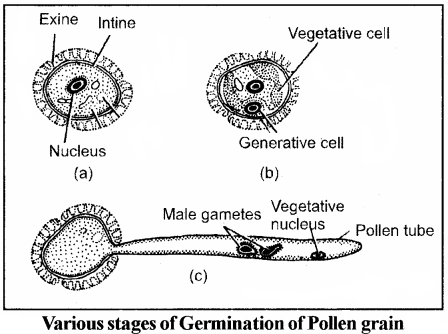
Vegetative cell:
Size of vegetative cells is large. Its nucleus is initially round-shaped and later on becomes undefined shaped. There is an increase in the shape and size of various organelles. It contains an adequate amount of RNA and proteins as the vacuoles disappear. The pollen tube is formed by vegetative cell probably at the time of germination.
Generative cell:
Initially, the generative cell is lens-shaped and after separation from the wall of the pollen grain, it becomes round shaped. At the initial stages of development, it’s shaping changes. Generally, it appears elongated like worm-shaped. Their longer shape allows their easy movement in the pollen tube. A generative cell contains all organelles and cytoplasm is found in very small quantity.
Both, generative and vegetative cells have an equal amount of DNA but the amount of RNA is different in the cytoplasm. Amount of RNA is more in the vegetative cell as compared to generative cell because of the large amount of cytoplasm in the vegetative cell.
Formation of male gametes:
Male gametes are formed by division of the generative cell. In some plants, the mitotic division of generative cell takes place after pollination but prior to germination of a pollen grain. Example: Portulaca, Haloptelea etc.
However, in most angiosperms, the generative cell divides by mitotic division in the pollen tube just after the germination of the pollen grains. The pollen tube grows through the stigma and the vegetative nucleus moves in the pollen tube and after this, the generative cell moves in the pollen tube.
Hereby the division of the generative cell, two male gametes are formed. Thus in the majority of angiosperms, male gametes are formed in the pollen tube while it is growing through the stylar region. Example: Lilium, Nimophilla etc. Each male gamete is unicellular, non-motile, and uninucleated structure.
Note: In the majority of angiosperms, pollination takes place at the two-celled stage of pollen grains and two male gametes are formed in the pollen tube while it is growing through the stylar region.
Question 5.
Describe the development of embryo sac in angiosperm with the help of well-labelled diagrams.
Answer:
The megaspore is the first cell generation of the female gametophyte or the embryo sac of angiosperms. The first division of the nucleus of functional megaspore gives rise to two nuclei, one at the micropylar end and the other at the chalazal end of the elongated megaspore cell.
![]()
“The second division forms a pair of nuclei at each end and the third division produces four nuclei at one end and four on the other end”. Subsequently, three of the four nuclei at the micropylar end become organized and form an egg apparatus consisting of one egg cell and two synergids. The fourth nucleus migrates towards the centre and is called polar nucleus.
Of the four nuclei at the chalazal end, three organize into antipodal cells. The fourth nucleus migrates towards the centre and is called polar nucleus. Thus the mature embryosac has egg apparatus at the micropylar end, three antipodal cells at the chalazal end and two polar nuclei in the centre.
Development of Female Gametophyte or Embryo sac:
The first division of functional megaspore gives rise to two nuclei, the primary micropylar and primary chalazal nuclei. The second division results in one pair of nuclei at each end, and the third division produces four nuclei at one end and four on the other end (i.e., at opposite poles of the now elongated developing embryo sac).
Three of the nuclei at the micropylar end become organized to form the egg apparatus and one nucleus which does not participate in the formation of the egg apparatus and is called polar nucleus. At the opposite (chalazal) end of the developing embryo sac, three nuclei differentiate as antipodal cells (or nucleus) and the fourth nucleus forms the polar nucleus.
The two polar nuclei from opposite ends (micropylar, and chalazal) migrate in the centre of embryo sac giving rise to the secondary nucleus ( = definitive nucleus). Most of the angiosperms have this type of embryo sac development and is known as a normal type or Polygonum type. When the embryo sac develops from one megaspore, it is called as monosporic embryo sac.
![]()
Structure of the Mature embryo sac:
A typical mature embryo sac consists of a large cell with two polar nuclei (which on fusion give rise to the secondary nucleus in the centre). At the micropylar end there is an egg apparatus (1 egg cell with 2 synergids) and at its chalazal end are found 3 antipodals. The cells of the egg apparatus and antipodal cells are uninucleate and haploid but the central cell is first binucleate. The two polar nuclei, later on, fuse to form a diploid nucleus called secondary nucleus ( = definitive nucleus).
